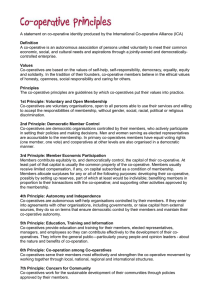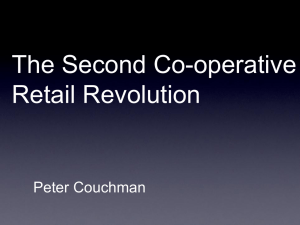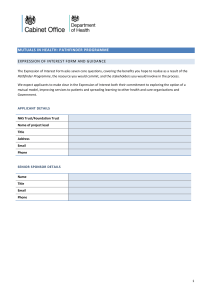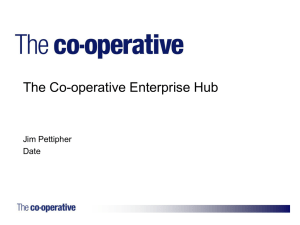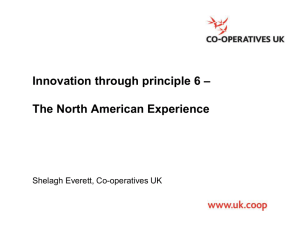Empowerment to the People - University of St Andrews
advertisement
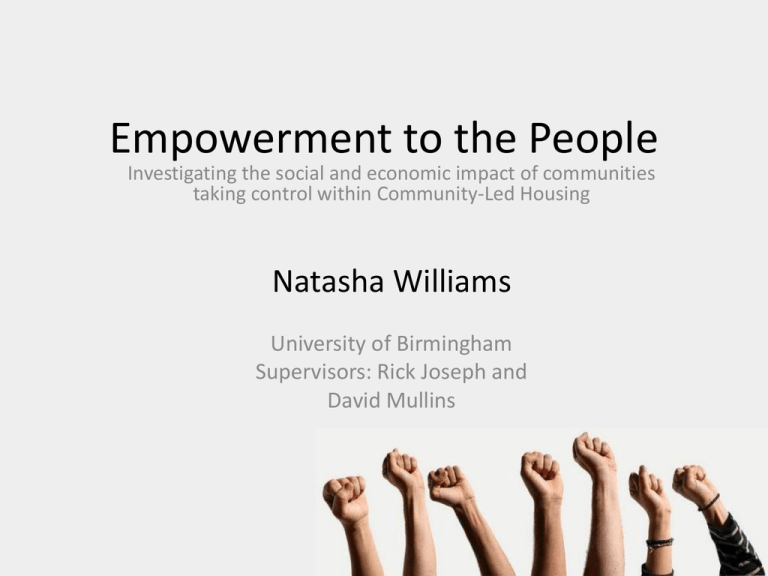
Empowerment to the People Investigating the social and economic impact of communities taking control within Community-Led Housing Natasha Williams University of Birmingham Supervisors: Rick Joseph and David Mullins Outline • • • • • • • Localism agenda Overview of the Housing Cooperative Sector European Comparatives Co-operatives & Mutual Housing – Differences The Community Gateway Model Research Question(s) Methodology Localism Agenda • Devolving service delivery and governance from government to local communities • “Too much has been imposed from above, when experience shows that success depends on communities themselves having the power and taking the responsibility. • It’s no good officials in Whitehall or even the Town Hall telling people what is needed in their street.” • …. everyone has a stake based on equal rights and where they pay their dues by exercising responsibility in return, and where local communities shape their own futures. Overview of the Sector The co-operative housing sector is small – just 0.6% of total housing stock of 16 million homes – – – – – – – – 836 co-operative and mutual housing organisations Managing over 169,000 homes 92,000 (54%) owned by co-operative/mutuals 77,000 (46%) managed by tenants 62% registered with UK housing regulators 91% in England, 5% in Scotland, 3% in Wales 54% in London (71% of TMOs) – rest mainly in other urban areas 4 Community Gateway Housing Associations – Preston, London, Watford and Braintree, Essex European Comparatives In Turkey: 25% of the total housing stock with 1,408,603 units In Sweden: 18% of the total housing stock with 750,000 units In Norway: 15% of the total housing stock with 320,000 units In Germany: 10% of the total rental housing stock with 2,200,000 units In Austria: 8% of the total housing stock with 334,000 units In Portugal: 1/3 of the social housing portfolio with 180,000 units Co-operatives & Mutual Housing Differences • Government funded ownership housing cooperatives – members & tenants own, manage and democratically control their housing • Tenant Management – Tenants of local authority or housing associations take responsibility for the democratic management features of the delivery of housing services – Right to Manage The Community Gateway Model • The Community Gateway Association is a type of not-for-profit organisation that can be used to manage council housing or take ownership of it as a “registered social landlord”. • Developed through the Co-operative Movement • Support from Government and financial organisations who lend to housing associations Key Features • • • • • Stock transferred estates (LSVT) Mutual housing Own assets collectively Governance – Tenants make up majority of management board Led by residents for residents Key objective: ‘Promote community empowerment, community control and community ownership’ Why Empower? • Sense of community • Contact theory – More positive contact that people experience with other groups the more tolerant of difference and willing to work together • Achieved through learning and collective organising • Require a redistribution of power – culture shift Research Question(s) • How can communities improve their deprivation levels by through resident-led initiatives within housing cooperatives and mutual housing. • Investigate – Approach to localism – Types and significance of social capital – Umbrella organisations/intermediaries/ institutional support structures – How residents are empowered Methodology • • • • • Institutional focus – Hybrid organisations Literature Review Policy analysis Case studies focusing Community Gateways Mixed methods THANK YOU FOR LISTENING References • CCMH (2009) Bringing Democracy Home • Czischke, D., Gruis, V and Mullins, D. (2012) Conceptualising Social Enterprise in Housing Organisations, Housing Studies 27:4, 418 – 437 • Lawson, L and Kearns, A (2010) ‘Community Empowerment’ in the Context of the Glasgow Housing Stock Transfer • McKee, K (2009). The ‘Responsible’ Tenant and the Problem of Apathy. Social Policy and Society, 8:01 pp 25-36 • Olsson, J and Hysing, E (2012). Theorizing Inside Activism: Understanding Policy Making and Policy Change from Below, Planning Theory and Practice, 13:2, 257-273 • Sacranie, H. (2012) Hybridity Enhacted in a Large English Housing Association: A tale of Strategy, Culture and Community Investment, Housing Studies, 27:4, 533-552
